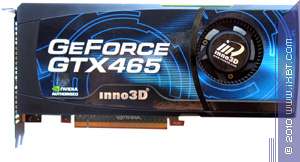NVIDIA GeForce GTX 465, GTX 470 Graphics Cards
|
As you know, not all GF100 GPUs are produced without defects. The nondefective ones are used in GeForce GTX 480 graphics cards; those that only have a few billion bad transistors or so have corresponding GPU parts disabled and are used in making GeForce GTX 470 products. But there are also GPUs that only have about two thirds of the core working. That's how GeForce GTX 465 has come to life. It has a GPU with 352 stream processors, 48 TMUs and 36 ROPs, a 256-bit bus instead of a 320-bit one, 1024MB of memory instead of 1280MB, and features a GeForce GTX 470 PCB. Obviously, the MSRP is also reduced -- down to $279.
Today we shall review NVIDIA GeForce GTX 465 graphics card as well as a couple of original GeForce GTX 470 cards from Gainward and InnoVision.
Card design
| Gainward GeForce GTX 470 1280MB GDDR5 Golden Sample |
- GPU: GeForce GTX 470 (GF100)
- Interface: PCIe 2.0 x16
- GPU (ROPs/Shaders) clock rate: 656/1315 MHz (vs. the standard 607/1215 MHz)
- Memory clock rate, physical (effective): 850 (3400) MHz (vs. the standard 840 (3360) MHz)
- Bus width: 320-bit
- Vertex processors: -
- Pixel processors: -
- Unified processors: 448
- TMUs: 56 (BLF/TLF/ANIS)
- ROPs: 40
- Dimensions: 270x100x33mm
- PCB color: red
- RAMDACs/TDMS: integrated into GPU
- Outputs: 2 x DVI (Dual-Link/HDMI), DisplayPort, HDMI
- Multi-GPU mode: SLI (Hardware)
|
 |
| Inno3D GeForce GTX 470 Hawk 1280MB |
- GPU: GeForce GTX 470 (GF100)
- Interface: PCIe 2.0 x16
- GPU (ROPs/Shaders) clock rate: 607/1215 MHz (standard)
- Memory clock rate, physical (effective): 840 (3360) MHz (standard)
- Bus width: 320-bit
- Vertex processors: -
- Pixel processors: -
- Unified processors: 448
- TMUs: 56 (BLF/TLF/ANIS)
- ROPs: 40
- Dimensions: 270x100x38mm
- PCB color: green
- RAMDACs/TDMS: integrated into GPU
- Outputs: 2 x DVI (Dual-Link/HDMI), HDMI mini
- Multi-GPU mode: SLI (Hardware)
|
 |
| Inno3D GeForce GTX 465 1024MB |
- GPU: GeForce GTX 465 (GF100)
- Interface: PCIe 2.0 x16
- GPU (ROPs/Shaders) clock rate: 607/1215 MHz (standard)
- Memory clock rate, physical (effective): 800 (3200) MHz (standard)
- Bus width: 256-bit
- Vertex processors: -
- Pixel processors: -
- Unified processors: 352
- TMUs: 48 (BLF/TLF/ANIS)
- ROPs: 36
- Dimensions: 270x100x33mm
- PCB color: green
- RAMDACs/TDMS: integrated into GPU
- Outputs: 2 x DVI (Dual-Link/HDMI), HDMI mini
- Multi-GPU mode: SLI (Hardware)
|
 |
Gainward GeForce GTX 470 1280MB GDDR5 Golden Sample
Inno3D GeForce GTX 470 Hawk 1280MB |
1280MB of GDDR5 SDRAM in 10 Hynix memory chips on the front side of the PCB. Peak clock rate 1000 (4000) MHz. |
 |
| Inno3D GeForce GTX 465 1024MB |
| 1024MB of GDDR5 SDRAM in 8 Hynix memory chips on the front side of the PCB. Peak clock rate 1000 (4000) MHz. |
 |
| Comparison with the reference design, front view |
| Gainward GeForce GTX 470 1280MB GDDR5 Golden Sample |
Reference NVIDIA GeForce GTX 470 |
 |
 |
| Inno3D GeForce GTX 470 Hawk 1280MB |
 |
| Inno3D GeForce GTX 465 1024MB |
 |
| Comparison with the reference design, rear view |
| Gainward GeForce GTX 470 1280MB GDDR5 Golden Sample |
Reference NVIDIA GeForce GTX 470 |
 |
 |
| Inno3D GeForce GTX 470 Hawk 1280MB |
 |
| Inno3D GeForce GTX 465 1024MB |
 |
As I already stated above, GeForce GTX 465 is a cut-down variant of GeForce GTX 470. For this reason both graphics cards have the same PCBs. It's just that GeForce GTX 465 lacks two memory chips, hence 1024MB instead of 1280MB and 256-bit bus instead of a 320-bit one. In all other aspects, it's a copy of GeForce GTX 470. Inno3D GeForce GTX 465 1024MB also has a reference cooler.
In turn, both GeForce GTX 470 graphics cards are original products. Note that all three solution we review today are made by respective companies. Of course, the design is based on the reference, but while Inno3D copied it completely, Gainward and Palit reworked PCB circuitry. Gainward also overclocked its Golden Sample card. Both GeForce GTX 470 cards also carry original coolers which we'll review a bit later today.
These graphics cards have audio codecs and can transmit both video and audio via HDMI.
Two such cards, organized into a SLI configuration, can output signal to three monitors at once, similar to ATI EyeFinity.
And remember that each card has two 6-pin supplementary power connectors.
Maximum resolutions and frequencies:
- 240 Hz maximum refresh rate
- 2048 x 1536 x 32bit @ 85Hz Max -- analog interface
- 2560 x 1600 @ 60Hz Max -- digital interface (Dual-Link DVI/HDMI)
As for the HDTV support, a review is available here.
Write a comment below. No registration needed!
|
|
 |
|
|
|
